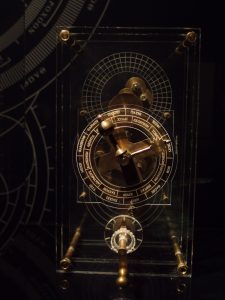
Another layer of mystery surrounding the ancient computer known as the Antikythera Mechanism has been decoded using, of all things, a technique developed for analyzing gravitational waves generated by the collision of black holes as they pass through the Earth. This analysis not only settles a long-standing issue with a previously-hidden unit of measurement used by the device, but it also revealed the high degree of precision used in making the mechanism, a level of craftsmanship that would not be seen again until 1,500 years after the clockwork mechanism’s creation.
Recovered from a 1st-century Roman shipwreck in 1901, the Antikythera Mechanism is considered to be the world’s oldest known analog computer, at an estimated 2,200 years old. While the device’s mechanism has long been assumed to have facilitated astronomical calculations, it wasn’t until the past few decades that the technology to properly analyze the mechanism’s approximately 30 bronze gears has been developed, as the device’s gears had corroded into a single lump over the two millennia that it laid on the seafloor.
Although it has since been revealed that the function of the clockwork computer is to simulate the motions of celestial bodies, including the positions of the visible planets and prediction of eclipses, it was less clear as to what system of calendar the builder of the device was using, affecting the length of the year incorporated into its mechanism. The two most likely candidates were the 365-day solar calendar used by the Egyptians; the other being the 354-day lunar year used by the ancient Greeks.
This measurement was originally incorporated into the Antikythera mechanism via a series of precisely-spaced holes placed below the device’s calendar ring; unfortunately, a portion of this gear is missing, having broken off at some point during its time at the bottom of the Aegean Sea, preventing a precise count of the holes. Enter Graham Woan, a Professor with the University of Glasgow’s School of Physics & Astronomy, who heard about the ancient puzzle through social media and decided to see if some advanced mathematics could solve the problem.
“Towards the end of last year, a colleague pointed to me to data acquired by YouTuber Chris Budiselic, who was looking to make a replica of the calendar ring and was investigating ways to determine just how many holes it contained,” Woan recounted. “It struck me as an interesting problem, and one that I thought I might be able to solve in a different way during the Christmas holidays, so I set about using some statistical techniques to answer the question.”
Using a statistical method called Bayesian analysis, Woan found that the most likely number of holes was either 354 or 355; however, the probability presented by his calculations didn’t seem strong enough to definitively say that that was the number of days in the year used by the mechanism, so Woan contacted a colleague, Dr. Joseph Bayley, a fellow professor with the University’s Institute for Gravitational Research.
As a researcher involved in the analysis of gravitational waves recorded by the Laser Interferometer Gravitational-Wave Observatory (LIGO), Bayley, along with Woan, adapted another statistical method to determine the original number of markers, a sampling method initially developed for analyzing gravitational signals from black hole and neutron star mergers picked up by LIGO’s observatories.
Their analysis revealed that there was indeed supposed to be either 354 or 355 holes on the ring, arranged in a circle with a diameter of 77.1 millimeters (3.035 inches), all but confirming the incorporation of the Greek lunar calendar in the Antikythera mechanism’s programming.
“Previous studies had suggested that the calendar ring was likely to have tracked the lunar calendar, but the dual techniques we’ve applied in this piece of work greatly increase the likelihood that this was the case,” according to Bayley.
The analysis also reconfirms that whoever crafted the Antikythera mechanism was capable of a high degree of precision, with the positioning of the holes displaying an average radial variation of just 0.028mm (0.0011 inches) between each marker—about one-third of the width of a human hair.
“It’s given me a new appreciation for the Antikythera mechanism and the work and care that Greek craftspeople put into making it—the precision of the holes’ positioning would have required highly accurate measurement techniques and an incredibly steady hand to punch them,” Bayley remarked.
“It’s a neat symmetry that we’ve adapted techniques we use to study the universe today to understand more about a mechanism that helped people keep track of the heavens nearly two millennia ago,” Woan pointed out. “We hope that our findings about the Antikythera mechanism, although less supernaturally spectacular than those made by Indiana Jones, will help deepen our understanding of how this remarkable device was made and used…”
Subscribers, to watch the subscriber version of the video, first log in then click on Dreamland Subscriber-Only Video Podcast link.